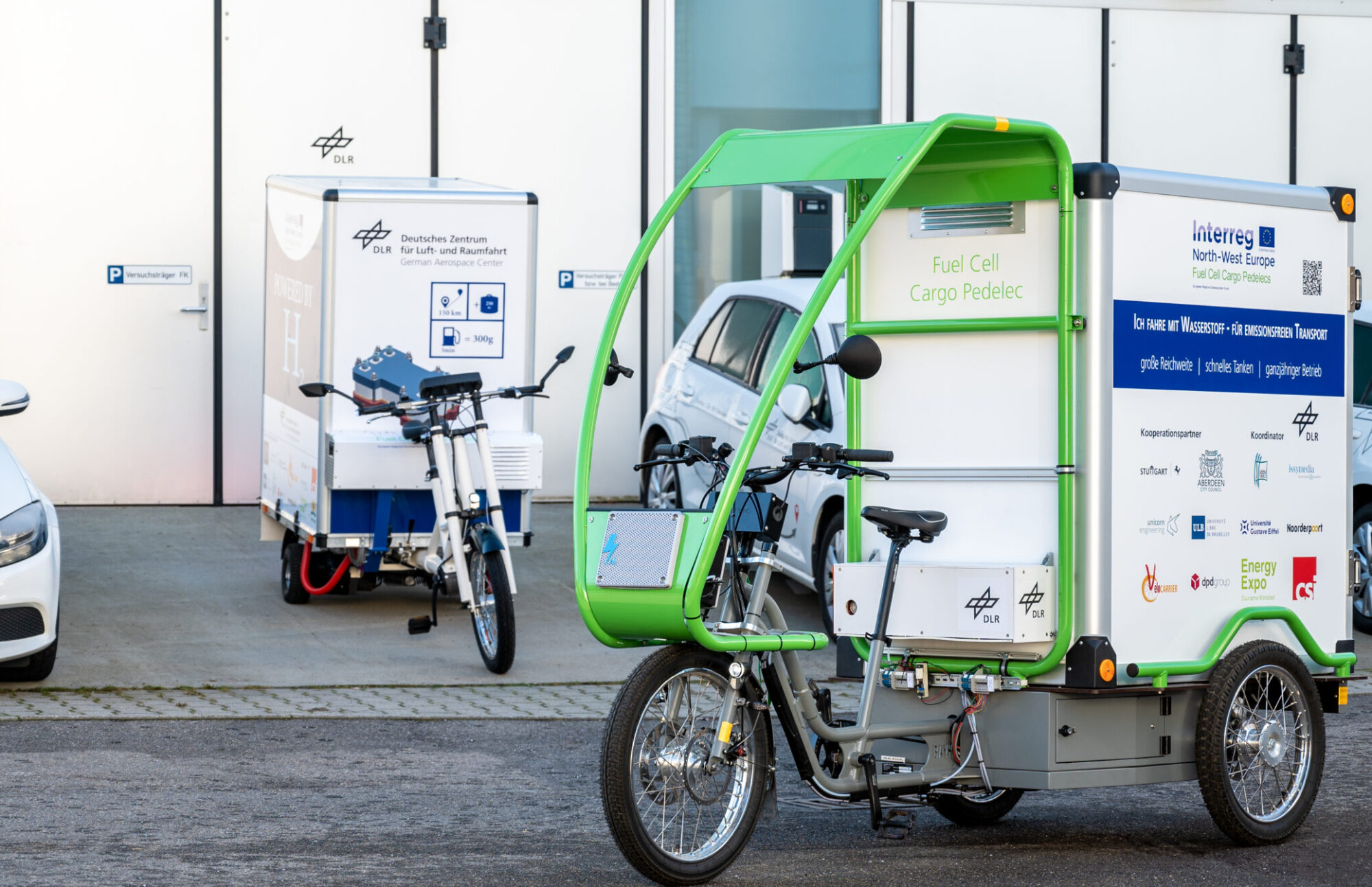Education FCCP: Specific FCCP logistics

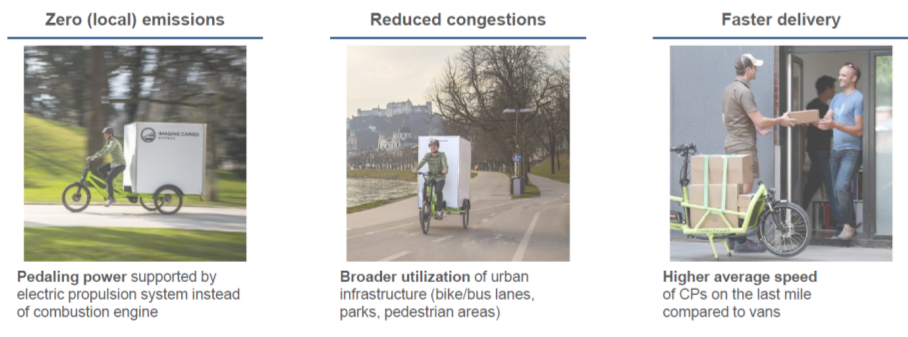
The cargo bike is not a new invention. Especially at the beginning of the last century it was very good and useful. The cargo bike reduces congestion just by using a broader but already existing infrastructure so with the cargo bike you can use the bus line, the bike line and in some cities you can enter the production areas or you can enter the parks and so you can also reduce the delays. Today cargo bikes in cities reach a high average speed on the last mile. The use of only batteries as energy carrier will restrict the use of the cargo bike; for example because of the poor battery performance in winter, the recharging time of several hours and as a consequence the of spare batteries. This again request a place to store the spare batteries and chargers. Furthermore appreciated heating of the cabin requests even more battery capacity.
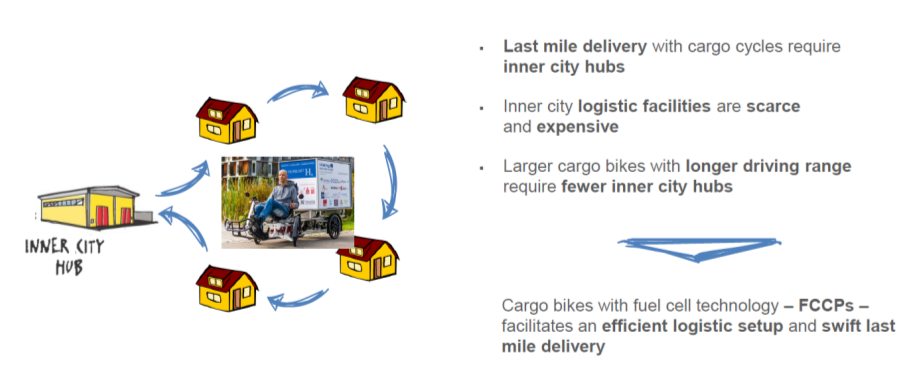
The figure shows the advantages from the FCCP cargo bike for this logistics concept: In the city centres it needs no space for storing and charging batteries. Also larger cargo bikes with longer driving range can be used meaning it requires fewer inner city hubs.
Cargo bike use cases are ecologically and economically relevant for future FCCP business models. Here last mile logistics is one of the main field of application. Furthermore of interest are direct shipments for food and spare parts. So the use cases where delivery speed is important. Another municipal use case is the Hamburg’s city cleaning.
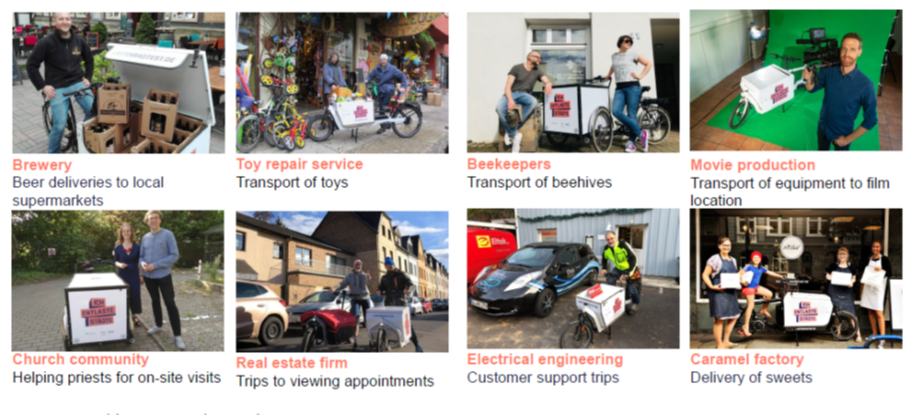
There are many more options for applications of the cargo bike as shown in the figure above.
Some of these use cases have been studied within the goals of the FCCP project. This first use case is about the use of cargo bikes such as the FCCP to deliver parcels in the last mile. This use case requires a network of micro hubs. The use case has been studied from collected data from a large logistics company in the centre of Stuttgart, Germany. Its current distribution network uses about 22 vans for around 2000 points a day in the city of in city centre of Stuttgart. Based on this data the simulated new distribution model using FCCP and the network of micro hubs has been applied. The results showed that it is possible to replace the 22 vans used currently by 25 FCCP’s. See figure below.
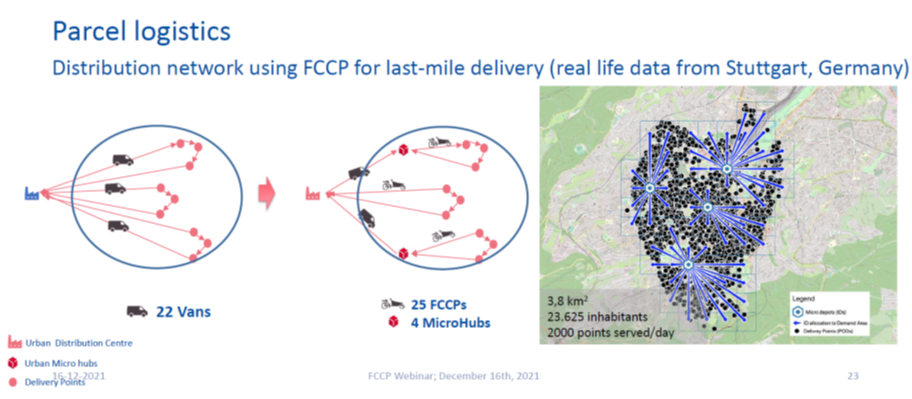
So cargo bike usage is feasible for professional logistics. For sure it is a challenge to add another transhipment point into the logistics chain. However in the integrated approach it has a chance to become economically viable.
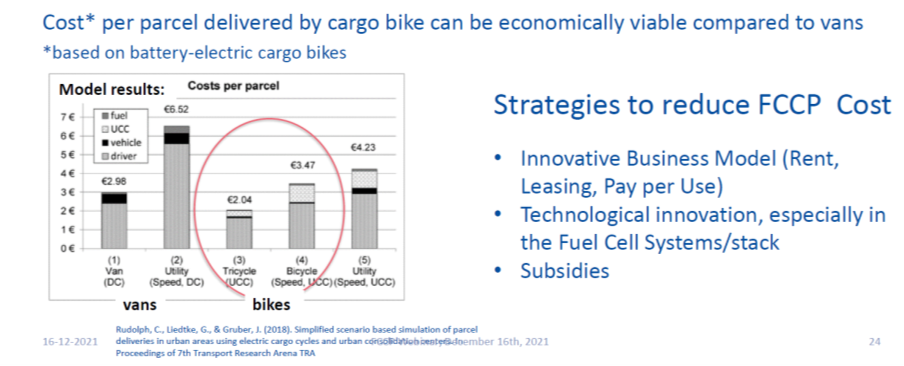
Awaiting for the real life results on FCCP’s simulation models have been used. These models evaluate deliveries with conventional diesel van versus bike cargo bike deliveries, both for regular overnight delivery and speed delivery. As show within the red circle in Figure above, it is foreseen that they can be cheaper per parcel than conventional diesel vans.
Compared to today’s battery electric cargo bikes so today’s fuel cell cargo bikes have a higher price and but the goal should be that the cost of FCCP approaches today’s battery electric prices. Therefore the FCCP project also explores strategies to reduce these costs and thus develops innovative business models needs to like renting and leasing models of these vehicles. Also there is a lot to gain from technological innovation especially when it comes to the fuel cell systems and its production process. Thirdly there are options for subsidies and public funding need to be involved at least in the initial phase of this development.

The use cases also includes the operative performance, especially if cargo bikes shall be used for speed deliveries competitive or at least as fast as traditional cars and vans. Figure above shows the comparison of travel times of cargo bikes and cars from recorded data from Germany in a very broad range of type of usages of businesses. The point clouds largely overlap until three kilometres so that means that the trips up on 2-3 kilometres are equally fast. From five km the two clouds separate more and more. Not included here but certainly relevant is additional parking time or time due to congestion which increases the delivery time for vans and cars. So if there is if there is increasing congestion and or too limited parking these speed advantages for cargo bikes will even be there for higher ranges of trip distances.
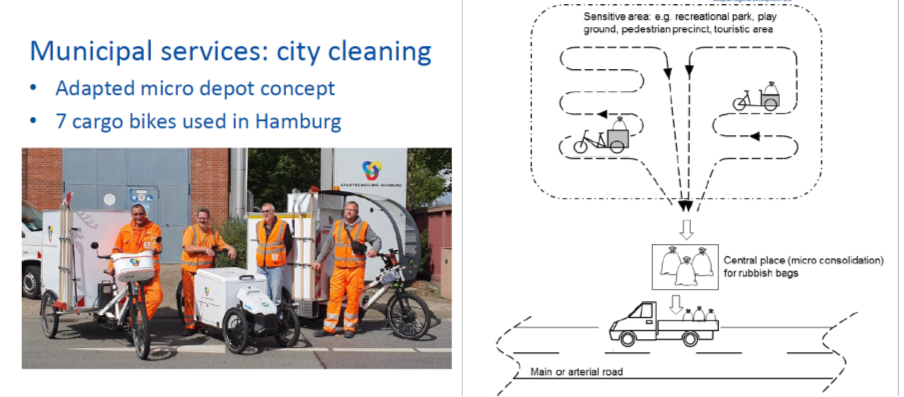
A different field of application is the application into municipal services. Figure above shows the example of Hamburg’s city cleaning. There are for sure other types of municipal usages that can be fruitful for instance the maintenance of parks and greenery other agencies that need trips between their and locations and social services et cetera. In Hamburg seven cargo bikes assist city cleaning in dense and peripheral areas.

This real life in pilot in has been run for two Hamburg areas (Figure above): one densely populated area close to the city centre and one peripheral suburban area. Vehicle tracking was used before and after to compare the before and after stage. In the before stage four trucks in the dense area four trucks have been used and three trucks in the peripheral area. In the after stage there’s a combined usage of trucks and battery electric cargo bikes. Each of the area shows good rates of reduction when it comes to CO2 emissions which is a goal definitely for the municipality. Concerning cost it appeared that the remain constant or even can be lowered by 23% in a dense area.
Summary of deliverables: link
- WP T1 Deliverable 1.1 Structure analysis of Participating Cities
- WP T1 Deliverable 1.2 Requirements of parcel service providers regarding Micro Depots
- WP T1 Deliverable 1.3 Requirements of online retailers
- WP T1 Deliverable 1.4 Overview of the legal frameworks in the participating cities
- WP T1 Deliverable 1.5 Modelling framework for last-mile distribution networks
- WP T1 Deliverable 5.1 Identification of at least five further application fields for FCCPs
- WP T1 Deliverable 6.1 Report to recommendations and guidelines for public policies
Restricted area (FCCP project members; For the links: please login on the FCCP teams site)
The theoretical base consists of:
- WP T1 Deliverable 1.1 Structure analysis, link
- WP T1 Deliverable 1.2 Requirements of parcel service providers, link
- WP T1 Deliverable 1.3 Requirements of online retailers, link
- WP T1 Deliverable 1.4 Overview of the legal frameworks in the participating cities, link
- WP T1 Deliverable 1.5 Modelling framework for last-mile distribution networks, link
- WP T1 Deliverable 5.1 Further Applications Fields, link
- WP T1 Deliverable 6.1 Report to recommendations and guidelines for public policies, link
